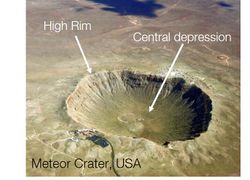Lab-0025
Cratered Landscapes
Contributor(s)

Classroom organization
Although we understand the process of cratering reasonably well we have a limited understanding about how cratering and the cratered surface influences the role of other longer-term surface processes. For example, on heavily cratered surfaces of the Moon, Mars, and Mercury, which have not been altered by plate tectonics like on Earth, how do the craters affect the flow and collection of water? Of wind? And of the sediments transported by both water and wind? These are fundamental questions in our understanding of planetary bodies and their potential habitability. This lab introduces what we know about impact cratering, some of the principles we use to simulate a cratered surface (after Howard, 2007), and allows students to explore the effects of stream-power erosion and diffusive erosion on a cratered landscape. Throughout this lab, quantities relevant to Mars are used, but impact cratering is a universal process across our solar system and the models could just as easily be applied to any cratered surface, while the surface processes could be modified to reflect the relevant processes on that planetary body.
Download associated file: ESPIn-2021 Presentation LessonVersion.pptx
Mainly visual presentation introducing the importance of considering cratering, and basic concepts related to crater formation.
Skills
- Create functions to generate crater topography
- Interact with and change input parameters that describe impact cratering
- Use LandLab model grids
- Use Landlab components to model surface evolution
- Visualize surface data and other data in python
- The importance of considering impact cratering as a geomorphic agent
- Simulating crater distribution and morphology
- Basic theory and simulation of landscape diffusion
- Basic theory and simulation of river erosion
- Effects of diffusion and river erosion on a cratered landscape
Lab notes
This lab would work best with an introduction to cratering as a geomorphic process, and the importance of cratering as an age constraint for planetary surfaces. There is enough information that students with limited coding experience could read and run the notebook independently, as there is only one input for an initial number of craters. Students experienced with coding will be able to change parameters and explore the effects. There are several short, open-ended questions scattered throughout that could be used as a problem set or points of discussion.
This lab can be run on the explore (for educators) and jupyter (for general use) instances of EarthscapeHub: just click one of the links under the Run online using heading at the top of this page, then run the notebook in the "CSDMS" kernel.
If you don't already have an EarthscapeHub account, follow the instructions to sign up at https://csdms.colorado.edu/wiki/JupyterHub. If you're an educator, you can get EarthscapeHub accounts for you and your students--please contact us through the CSDMS Help Desk: https://csdms.github.io/help-desk.
Requirements
This lab requires the Python packages numpy, matplotlib, and landlab, which must be installed if run locally. On the CSDMS JupyterHub no installation is required.
Acknowledgements
This material was enabled and encouraged by the contributors' participation in the Earth Surface Processes Institute (ESPIn) 2021.
References
- Howard, A. D. (2007). Simulating the development of Martian highland landscapes through the interaction of impact cratering, fluvial erosion, and variable hydrologic forcing. Geomorphology, 91(3–4), 332–363. https://doi.org/10.1016/j.geomorph.2007.04.017.
- Campforts, B., Overeem, I., Gasparini, N.M., Piper, M., and Arthurs, L., 2021: Modeling earth surface processes for the future: ESPIn, a summer school focusing on cyber training and professional networking, 2021 AGU Fall Meeting, New Orleans, LA.
